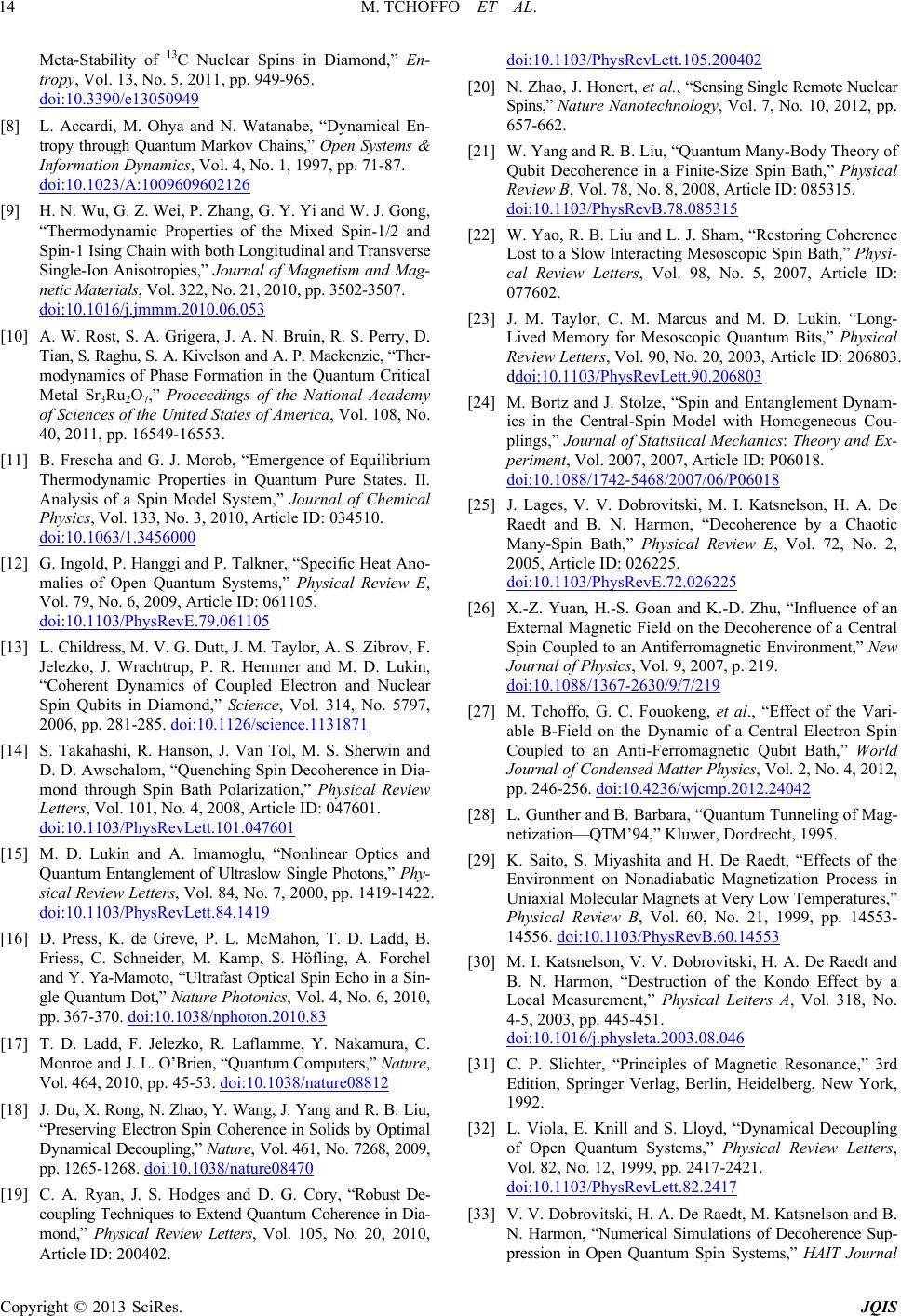
M. TCHOFFO ET AL.
14
Meta-Stability of 13C Nuclear Spins in Diamond,” En-
tropy, Vol. 13, No. 5, 2011, pp. 949-965.
doi:10.3390/e13050949
[8] L. Accardi, M. Ohya and N. Watanabe, “Dynamical En-
tropy through Quantum Markov Chains,” Open Systems &
Information Dynamics, Vol. 4, No. 1, 1997, pp. 71-87.
doi:10.1023/A:1009609602126
[9] H. N. Wu, G. Z. Wei, P. Zhang, G. Y. Yi and W. J. Gong,
“Thermodynamic Properties of the Mixed Spin-1/2 and
Spin-1 Ising Chain with both Longitudinal and Transverse
Single-Ion Anisotropies,” Journal of Magnetism and Mag-
netic Materials, Vol. 322, No. 21, 2010, pp. 3502-3507.
doi:10.1016/j.jmmm.2010.06.053
[10] A. W. Rost, S. A. Grigera, J. A. N. Bruin, R. S. Perry, D.
Tian, S. Raghu, S. A. Kivelson and A. P. Mackenzie, “Ther-
modynamics of Phase Formation in the Quantum Critical
Metal Sr3Ru2O7,” Proceedings of the National Academy
of Sciences of the United States of America, Vol. 108, No.
40, 2011, pp. 16549-16553.
[11] B. Frescha and G. J. Morob, “Emergence of Equilibrium
Thermodynamic Properties in Quantum Pure States. II.
Analysis of a Spin Model System,” Journal of Chemical
Physics, Vol. 133, No. 3, 2010, Article ID: 034510.
doi:10.1063/1.3456000
[12] G. Ingold, P. Hanggi and P. Talkner, “Specific Heat Ano-
malies of Open Quantum Systems,” Physical Review E,
Vol. 79, No. 6, 2009, Article ID: 061105.
doi:10.1103/PhysRevE.79.061105
[13] L. Childress, M. V. G. Dutt, J. M. Taylor, A. S. Zibrov, F.
Jelezko, J. Wrachtrup, P. R. Hemmer and M. D. Lukin,
“Coherent Dynamics of Coupled Electron and Nuclear
Spin Qubits in Diamond,” Science, Vol. 314, No. 5797,
2006, pp. 281-285. doi:10.1126/science.1131871
[14] S. Takahashi, R. Hanson, J. Van Tol, M. S. Sherwin and
D. D. Awschalom, “Quenching Spin Decoherence in Dia-
mond through Spin Bath Polarization,” Physical Review
Letters, Vol. 101, No. 4, 2008, Article ID: 047601.
doi:10.1103/PhysRevLett.101.047601
[15] M. D. Lukin and A. Imamoglu, “Nonlinear Optics and
Quantum Entanglement of Ultraslow Single Photons,” Phy-
sical Review Letters, Vol. 84, No. 7, 2000, pp. 1419-1422.
doi:10.1103/PhysRevLett.84.1419
[16] D. Press, K. de Greve, P. L. McMahon, T. D. Ladd, B.
Friess, C. Schneider, M. Kamp, S. Höfling, A. Forchel
and Y. Ya-Mamoto, “Ultrafast Optical Spin Echo in a Sin-
gle Quantum Dot,” Nature Photonics, Vol. 4, No. 6, 2010,
pp. 367-370. doi:10.1038/nphoton.2010.83
[17] T. D. Ladd, F. Jelezko, R. Laflamme, Y. Nakamura, C.
Monroe and J. L. O’Brien, “Quantum Computers,” Nature,
Vol. 464, 2010, pp. 45-53. doi:10.1038/nature08812
[18] J. Du, X. Rong, N. Zhao, Y. Wang, J. Yang and R. B. Liu,
“Preserving Electron Spin Coherence in Solids by Optimal
Dynamical Decoupling,” Nature, Vol. 461, No. 7268, 2009,
pp. 1265-1268. doi:10.1038/nature08470
[19] C. A. Ryan, J. S. Hodges and D. G. Cory, “Robust De-
coupling Techniques to Extend Quantum Coherence in Dia-
mond,” Physical Review Letters, Vol. 105, No. 20, 2010,
Article ID: 200402.
doi:10.1103/PhysRevLett.105.200402
[20] N. Zhao, J. Honert, et al., “Sensing Single Remote Nuclear
Spins,” Nature Nanotechnology, Vol. 7, No. 10, 2012, pp.
657-662.
[21] W. Yang and R. B. Liu, “Quantum Many-Body Theory of
Qubit Decoherence in a Finite-Size Spin Bath,” Physical
Review B, Vol. 78, No. 8, 2008, Article ID: 085315.
doi:10.1103/PhysRevB.78.085315
[22] W. Yao, R. B. Liu and L. J. Sham, “Restoring Coherence
Lost to a Slow Interacting Mesoscopic Spin Bath,” Physi-
cal Review Letters, Vol. 98, No. 5, 2007, Article ID:
077602.
[23] J. M. Taylor, C. M. Marcus and M. D. Lukin, “Long-
Lived Memory for Mesoscopic Quantum Bits,” Physical
Review Letters, Vol. 90, No. 20, 2003, Article ID: 206803.
ddoi:10.1103/PhysRevLett.90.206803
[24] M. Bortz and J. Stolze, “Spin and Entanglement Dynam-
ics in the Central-Spin Model with Homogeneous Cou-
plings,” Journal of Statistical Mechanics: Theory and Ex-
periment, Vol. 2007, 2007, Article ID: P06018.
doi:10.1088/1742-5468/2007/06/P06018
[25] J. Lages, V. V. Dobrovitski, M. I. Katsnelson, H. A. De
Raedt and B. N. Harmon, “Decoherence by a Chaotic
Many-Spin Bath,” Physical Review E, Vol. 72, No. 2,
2005, Article ID: 026225.
doi:10.1103/PhysRevE.72.026225
[26] X.-Z. Yuan, H.-S. Goan and K.-D. Zhu, “Influence of an
External Magnetic Field on the Decoherence of a Central
Spin Coupled to an Antiferromagnetic Environment,” New
Journal of Physics, Vol. 9, 2007, p. 219.
doi:10.1088/1367-2630/9/7/219
[27] M. Tchoffo, G. C. Fouokeng, et al., “Effect of the Vari-
able B-Field on the Dynamic of a Central Electron Spin
Coupled to an Anti-Ferromagnetic Qubit Bath,” World
Journal of Condensed Matter Physics, Vol. 2, No. 4, 2012,
pp. 246-256. doi:10.4236/wjcmp.2012.24042
[28] L. Gunther and B. Barbara, “Quantum Tunneling of Mag-
netization—QTM’94,” Kluwer, Dordrecht, 1995.
[29] K. Saito, S. Miyashita and H. De Raedt, “Effects of the
Environment on Nonadiabatic Magnetization Process in
Uniaxial Molecular Magnets at Very Low Temperatures,”
Physical Review B, Vol. 60, No. 21, 1999, pp. 14553-
14556. doi:10.1103/PhysRevB.60.14553
[30] M. I. Katsnelson, V. V. Dobrovitski, H. A. De Raedt and
B. N. Harmon, “Destruction of the Kondo Effect by a
Local Measurement,” Physical Letters A, Vol. 318, No.
4-5, 2003, pp. 445-451.
doi:10.1016/j.physleta.2003.08.046
[31] C. P. Slichter, “Principles of Magnetic Resonance,” 3rd
Edition, Springer Verlag, Berlin, Heidelberg, New York,
1992.
[32] L. Viola, E. Knill and S. Lloyd, “Dynamical Decoupling
of Open Quantum Systems,” Physical Review Letters,
Vol. 82, No. 12, 1999, pp. 2417-2421.
doi:10.1103/PhysRevLett.82.2417
[33] V. V. Dobrovitski, H. A. De Raedt, M. Katsnelson and B.
N. Harmon, “Numerical Simulations of Decoherence Sup-
pression in Open Quantum Spin Systems,” HAIT Journal
Copyright © 2013 SciRes. JQIS